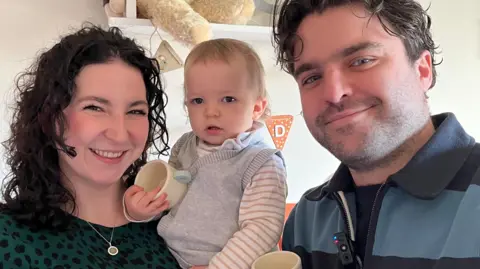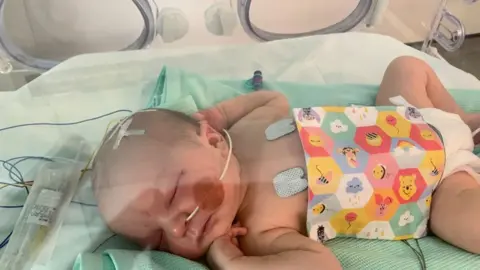My baby had seizures after 'petrifying' maternity experience
A couple whose baby suffered seizures and damage to his brain during labour have described their time in Edinburgh's maternity unit as "petrifying".
A review into Naomi Robertson and baby Roddy's care at Edinburgh Royal Infirmary found he suffered a brain injury after multiple missed opportunities for observation and treatment due to short-staffing and high numbers of complex patients.
Last month BBC Scotland News revealed that a whistleblowing investigation had found mothers and newborn babies came to harm because of rota shortages and a "toxic" culture at the ERI's obstetrics triage and assessment unit.
NHS Lothian said a significant programme of improvement work began in August 2024 and was still being implemented and closely monitored.

Staff who have spoken anonymously to BBC Scotland News said the situation had got worse since the whistleblowing report upheld or partially upheld 17 concerns about safety.
Midwives said the maternity unit was still "consistently dangerously short-staffed" and that they went into work every day fearful they would be involved in a case like Naomi's.
Baby Roddy was born at the Edinburgh unit in August 2023 but a short time later he suffered seizures which are thought to be related to being in distress at birth and his mother having sepsis.
A review of his birth later noted numerous delays and missed opportunities to pick up the problems earlier.
 Naomi Robertson
Naomi RobertsonWhile Roddy was being treated in neonatal intensive care, Naomi and her partner Alastair Clark were warned by doctors their son might not be able walk or talk.
Ms Robertson told BBC Scotland News: "There was about a five or six-hour-delay where there should have been four opportunities but they were all missed.
"And that really hurt me because my baby was in distress the whole time and nobody was doing anything.
"For a long time I blamed myself for that even though I know now it wasn't my fault."
The Serious Adverse Event Review into Roddy's birth found it was not until more than five hours after Naomi was admitted to hospital that maternal observations, such as blood pressure, heart rate and temperature, were taken.
It also said staff did not recognise Naomi was showing signs of sepsis and there were delays to starting treatment.
Maternal observations
It noted that taking observations earlier and starting treatment may have "prevented the worsening" of Naomi's condition and reduced the impact on Roddy.
The review also found that staff repeatedly missed readings when Naomi was in labour that showed Roddy's heart rate was high and he was gradually not getting enough oxygen.
When midwives buzzed for help, medical staff were not available because the unit was busy.
"It was petrifying," Naomi said.
"You just want to know that your baby's going to be safe."
Roddy was very quickly taken to the neonatal intensive care unit after being born, where he suffered seizures.
Tests were carried out including a lumbar puncture and an MRI and probes were fitted to his scalp to monitor the seizures.
"You wouldn't wish that upon anyone but to have to watch your baby go through that was horrible," Naomi said.
 Naomi Robertson
Naomi RobertsonIt was not until 40 hours after Roddy was born that Naomi was able to hold him.
The couple told the BBC they sensed it was "hectic" during their 11 days in hospital.
They felt staff spent a lot time "putting out fires" and not as much as they wanted with patients.
Naomi and Alastair said they did not blame the staff but felt the maternity unit was in "desperate need of change".
Roddy is now almost 18 months old and has met all major milestones in his development.
He has had to attend neurological appointments every three months and his parents were constantly worried.
A lot of uncertainty
Alastair said: "It was a long time to wait with a lot uncertainty if there was going to be lasting effects or not."
Despite wanting to have more children, the couple do not want to have another baby at the same hospital.
"You just have to put your 100% trust and faith in the doctors and midwives around you and actually at that point there was nobody I felt safe with," Naomi said.
"You're probably in one of the most vulnerable positions and you've got your baby to think about and yourself to think about and it just felt like we were really let down to be honest."
The labour ward at the Edinburgh Royal Infirmary supports about 6,000 births each year.
Staff who have spoken to BBC Scotland News said they did not take the decision to speak out lightly but they wanted to protect patients and believed the unit was "no safer" following the whistleblowing review.
One staff member said: "It needs to be highlighted that the short-staffing and issues regarding the toxic management culture towards staff, is endemic throughout every department in the maternity unit."
From this month, maternity units across Scotland will routinely face unannounced inspections by the NHS safety watchdog, Healthcare Improvement Scotland.
It comes in response to a number of spikes in newborn deaths in recent years.
Patient care reviewed
NHS Lothian said work was under way to enhance patient safety and quality of care.
It said the improvement process, which began in August last year, was being closely monitored by the health board's executive team.
Jim Crombie, NHS Lothian's deputy chief executive, said the health board was also reviewing staffing levels.
"The review of maternity services was completed in mid-December and in recognition of the rising complexity of some cases, we are adding a substantial number of posts," he said.
"The recruitment process to these new additional permanent posts is under way and in the interim, staffing levels are being augmented using appropriately trained staff from the staff bank."
Mr Crombie said he could not discuss individual patients but he repeated his apology to Naomi Robertson and her family.
"We reassure expectant mothers and their families that all aspects of patient care and workforce have been reviewed and providing high-quality care for mothers and their babies remains our utmost priority.
"It is for this reason that we actively encourage staff and patients to raise any concerns they may have with us."

There are things to weigh up when covering a story like this.
Inevitably, it will cause anxiety for pregnant women in Edinburgh who have little or no choice about where they give birth.
But it is also of public importance to report on serious safety issues that have been raised by staff.
The majority of women will have a positive experience of giving birth and have glowing reports of the care they received.
But after we first reported on the issue, several women got in touch with upsetting stories about their time on the unit.
And perhaps more striking is the number of staff who contacted us to voice their concerns.
That is highly unusual and an indication of the true scale of challenges facing the NHS and what it means for patient safety.

